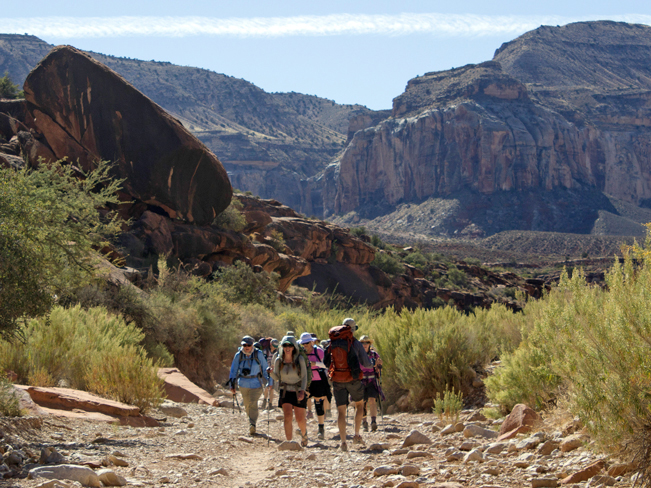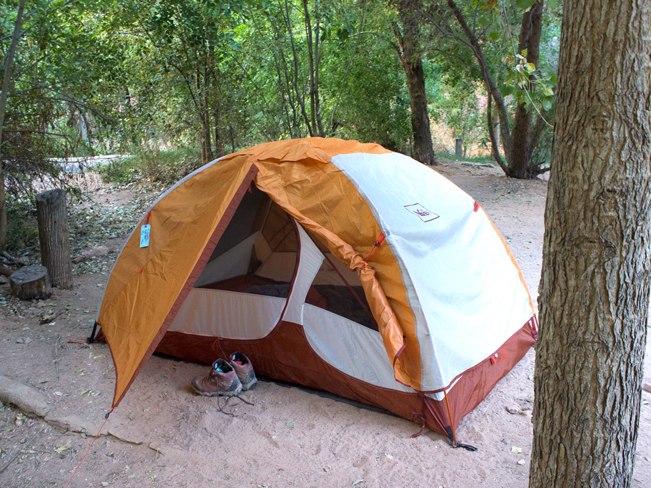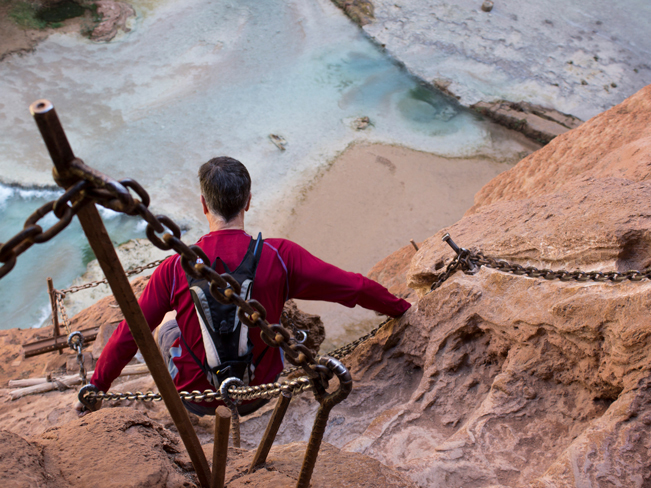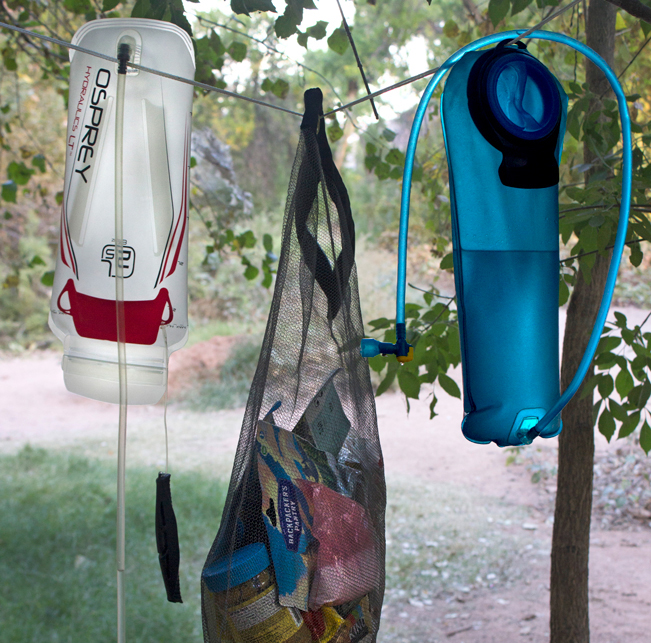Congratulations! You’ve scored a permit to visit Havasu Falls. And now you’re in serious planning mode. To help out, we’ve put together a recommended supply list (below) and downloadable checklist (with recommended weights, etc.) on what to tuck into your backpack. Plus, the camping descriptions below provide a good heads-up on the ins-and-outs of Havasu Falls camping.
(Side note: If you’re planning to purchase any of these or similar items, using the links below helps support AZ Utopia – at zero cost to you! We receive a teeny percent of the purchase price, which goes directly towards our hosting fees. We really appreciate it and thank you for thinking of us!):
Backpacking & Camping Essentials
For the 10 mile backpack into the canyon, aim for a base weight of 20-30 lbs.. Base weight is the sum weight of the items carried in and out (i.e. backpack, tent, sleeping bag, clothes, etc.), and not consumed (i.e. food & water).
Backpack – 45-65 liter capacity (depending on length of stay), lightweight, correctly-fit & water bladder system capable. Having a correctly fit backpack will greatly improve your hiking experience. REI is a solid source for fittings and adjustments. If you’re renting, your equipment house should be able to fit you. Among our favorite backpacks are the Men’s Gregory Zulu 65, Women’s Gregory Jade 63 and Osprey Aura 65.
Backpack rain cover (optional) – July through September, expect afternoon or evening rain.
Water Bladder – There are so many to choose from! We’re pretty keen on the design of the easy-open Osprey Bladders although Camelback Bladders are another solid option.
Hiking Poles – (optional) Poles come in really handy when carrying a backpacking load. They help distribute some of the weight to your arms. And provide much needed balance and support as the backpack’s heft pulls your body from side to side. We love the super light weight, easy-to-collapse design and grippy handles of Black Diamond’s Alpine Cork Trekking Poles. A slightly more expensive, but equally great pole, is the Leki Micro Vario Carbon.
Tent – Between 2-5.5 lbs. max., with stakes & rain fly for privacy and weather protection. The Havasu campsite is mostly flat with a good soil & sand floor. A footprint will help protect your tent floor, but is optional. Sprinkles are possible throughout the year, and afternoon rains should be expected July through September. Our favorite backpacking tents are the Big Agnes Copper Spur UL Classic, and Mountainsmith Morrison 2.
Sleeping Bag – Between 2-3.5 lbs. max. Man made fill is recommended, as the moist creek air tends to dampen down bags. A temperature rating is between 35-40° is generally fine April through October. In winter you’ll need a 20° temperature rated bag. Recommended sleeping bags include Women’s Big Agnes Slavonia 30°, or Mountain Hardwear’s Unisex Spark 34° or Lamina Long 20°.
Sleeping bag compression sack (optional) – Compression sacks squeeze your sleeping bag down into a teeny package. Fantastic for opening up space in your backpack.
Sleeping Pad – Although insulated mats are more expensive than foam pads, they do a much better job of fending off cold seeping up from the ground. We like the full-length, ultralight mat from Sea to Summit. A cheaper route is using a foam pad. Foam Pads are light, and easy to pack. But lack the padding and insulation of a mat. To us, an insulated mat is worth the spend.
Pillow (optional) – Lightweight & inflatable, if you bring one. We choose to store our clothes in a pillowcase, and use it as a pillow.
Patch kit (optional) – Tenacious tape is fantastic for on-the-fly tent or inflatables patching.
Rope – Stringing up a 15-20 foot length of guy line at your campsite is essential for for hanging wet items and food in a protective rat sack.
Headlamp & extra batteries – You’ll need light to get around the campground at night, or if you opt to hike out before sunrise (highly recommended in Summer to beat the heat). We’re crazy about Petzle’s bright lumens and super light weight.
Hammock & Straps (optional) – Extra weight, but oh-so-fun to hang around in. Our favorite is the ultralight ENO hammock.
Picnic tables are scattered throughout the Havasu campsite, so there’s no need to bring seating.
Clothing
Layers are the best way to dress in the desert, as temperatures vary 30-40 degrees from day to night.
Hiking shorts – We recommend packing one pair for each day in Havasu, Spring through Fall. We like the light weight, stretch, pockets, and SPF protection found in Columbia’s Silver Ridge shorts for men, and Saturday Trail Short for women.
Hiking pants – It’s good to have on pair of lightweight, hiking pants on hand for evenings and cool days, Spring through Fall. In winter bring a pair of long pants for each day, and one pair of shorts in case the weather warms up. Here again, we like Columbia’s light, stretchy Silver Ridge men’s cargo pants and women’s Saturday Trail long pants.
Sleeveless or short sleeve shirts – Athletic shirts help wick away sweat and help avoid chaffing, much better than cotton tees. And hiking shirts often come with SPF protection. Make sure that your shoulders are covered for both sun and backpack strap protection. Plan to bring one shirt for each day of your trip, Spring through Fall. There are a ton of brands to select from including The North Face and Columbia for women and men.
Long sleeve shirts – Moisture wicking athletic shirts. One for evening use, Spring through Fall. One for each day in Winter.
Brimmed Hat – A wide brim will minimize sun exposure on the 10-mile hike. Look for mesh panels for breathability and coolness.
Swimsuit – Hopefully it will get a lot of use! Kowabunga.
Underwear – You know… one per day.
Long base layer (winter months only) – A base layer will keep you warm when the cold sets in. Lightweight wool is your friend, with it’s anti-microbial properties (less stink prone) that stand up to for multi-day use. We like the quality of Smartwool’s Men’s and Women’s lightweight base layers.
PJs (optional) – Kinda nice to wrap up the evening in something clean & comfy.
Jacket or polar fleece – You’ll appreciate having a lightweight layer as the nights cool off – even in Summer. We recommend Mountain Hardwear’s men’s and women’s puffy jackets for both warmth and compactability. In winter you’ll need a heavier jacket.
Rain Shell (optional) – For July through September’s evening rains, it’s recommended that you bring a lightweight rain jacket. Columbia’s Men’s Watertight II and Women’s Arcadis II jackets pack down well and have a hide-away hood.
Socks – Enough for each day, plus one or two to keep blisters at bay. Wool socks wick moisture away and are anti-microbial (less stinky). Darn Tough socks offer a lifetime guarantee and are a hiking staple.
Hiking boots – Boots are recommended over shoes, for added ankle support while carrying a backpack. The deep lugs, grippy soles and amped-up toe and foot protection found on Men’s and Women’s Oboz Bridger Boots make them our favorite for rocky trails like this. Keen boots are another reliable option, as is Salomon.
Water shoes – You’ll really appreciate having a pair of rugged water shoes for swimming under Havasu Falls or making the trek out to Beaver Falls or the Colorado River (which requires wading across the creek many times). We’re big fans of the rugged, grippy soles found on Men’s and Women’s Keen’s Newport water shoes.
Flip Flops (optional) – They add a little weight. But are nice at the end of a long day of hiking!
Cooking Equipment, Food & Water
Campfires are not permitted in Havasu Canyon, and there are no grills. Any cooking must be done on portable butane or propane stoves. And ALL TRASH MUST BE PACKED OUT! A small store, in Supai Village, stocks basic groceries, if needed. A Fry Bread station (yum!) is open some evenings by the campground entrance. And a small local cafe in the village, is open intermittently. Potable water is readily available from a natural spring in the campground.
Water – For the 10-mile trek in and out of the canyon, bring 3-4 liters of water (there is no potable water along the trail until your reach Supai Village). A natural spring supplies drinking water to Havasu Campground.
Electrolyte Powder or Tabs (optional)- Really helpful for maintaining energy and replacing salts lost on the sweaty hike. We’re big fans of Ultima powders or Nuun tablets, but there are many good options in the market.
Water carrier & filter – A collapsable container with a handle is needed for carrying water from the spring to your campsite. It’s recommended to filter the spring water, but not required. We loved the Katadyn Filter and hyper-compactable Hydropack water container combo. They stuff super-small, but expand to handle a good volume of water.
Cook stove & fuel (optional) – Although it’s not necessary to bring a stove, there’s nothing like hot coffee in the morning and a warm meal at night. Lightweight options like JetBoil make this a breeze. A 230 gram fuel canister can boil up to 6 gallons of water. Plenty for two people over four days.
Bowl, cup with handle, utensils & mesh bag – Multi-purpose, lightweight dinnerware like Sea to Summit’s Delta Bowl, a good spork, and a double walled mug with handle for drinking hot or cold liquids, is all that’s really needed. Hang everything in a mesh sack to dry after cleanup.
Pocket knife -Bring an ultralight knife for opening stubborn packages, cutting food or rope.
Food protection – We highly recommend protecting your food from the campground’s hungry squirrels and mice, by hanging it outside in a gnaw-proof rat sack. This way you’ll also avoid having these critters, in search of food, chew holes chewed through your tent or pack! Believe us. It happens!
Reusable baggies – For packing day hike meals.
Small sponge and biodegradable dishwashing soap – We recommend CampSuds for a quick after-meal clean up.
Snacks – Easily packable and nutritious snacks include energy bars from Kind, Cliff or Larabar, mixed nuts, dried mangos, raisons, meat jerky, trail mix, candy and fresh apples & oranges. Although fresh fruit adds weight – we recommend bringing some along to retain some fresh food in your diet.
Meals – In general, look for lightweight foods that can stand up to getting bounced around in your backpack. Breakfast recommendations include instant oatmeal, granola, granola bars, Pop Tarts, instant coffee, tea bags and dried milk & sugar. Good lunch options include tortillas or bagels, filled with hard cheeses, hard meats, tuna or chicken pouches or peanut butter, jelly or honey. Single serving packets are an easy way to pack these items. Lightweight, freeze-dried meals by Mountain House or Backpackers (which are easy to prepare by adding hot water to their packages) are solid dinner options. Make sure to check that the meal doesn’t require additional cooking on a skillet. We discovered this the hard way with a package of freeze-dried scrambled eggs (Yuk!). Other choices include instant mashed potatoes or rice dishes, dried soups and ramen. Mini-carrots and snap peas hold up well and are good fresh food add-ons.
Trash bag(s) & twist ties – Visitors to Havasu Canyon are required to pack out their trash.
Bath & Safety Kits
Well-maintained vault toilets are located in the middle and on both ends of Havasu Campground. They are stocked with toilet paper and are lit at night.
Lightweight mess kit (optional) – To keep all your items together. We love the super-light durablility of Eagle Creek’s nylon zip bags.
Micro towel – Lightweight & quick drying, for after cleanup or swimming.
Toothbrush & toothpaste – Your choice.
Comb & hair ties – The lighter the better.
Body wipes and / or environmentally friendly soap – After a day or two a quick cleanup is welcome! Hint, dry out a small pack of wipes (for less carry weight) and re-moisten each one as needed.
Travel tissues & small baggies – Tissues in case Mother Nature gives you a surprise-call on the trail (please be sure to dig a cat hole). And small baggies to pack your tissues out.
Sunblock – You’ll need this! We’re partial to the summery scent of Hawaiian Tropic, but any good SPF brand will do.
Bug Repellant (optional) – We did not have any issues with bugs, but have heard that they are around sometimes. A travel sized Deet-free spray is an environmental friendly choice.
Basic Safety Items – Small packs of various sized Bandaids, Moleskins (for blisters), aspirin, tweezers, Tums.
Other Necessities
Small daypack – It’s nice to have a light pack to throw snacks & sunblock into if you hike out to Beaver Falls or the Colorado River. Zomake packs compress down to pocket size and are ultralight.
Small Water Bottle (optional) – For shorter day trips, where you don’t want to hassle with a water bladder. We really appreciate the light weight and easy packability of the Nomader BPA Free bottles.
Cell Phone and Battery Pack – Service is sketchy, but it’s good to have on hand for those Instagram-worthy moments.
Camera (optional) – It is almost impossible to take a bad photo in Havasu Canyon! Your choice. The lighter the better.
Equipment Checklist
Yours for downloading right here.
Hope you have a blast!! Havasu Canyon is truly a bucket list worthy adventure. For more information on the hike into Havasu Falls, or to Mooney and Beaver Fall and beyond, check out these links.









2 Responses to Havasu Falls Backpacking Supply Guide
This is an amazing ultimate guide, so complete. I love backpacking but with no scary drops, I really need to work on that as I know I am missing out on exciting adventures. Havasu Falls is so Beautiful. My wife would love this. This looks just like the thing they would truly enjoy. Anyway, love your beautiful photos. Thank you for this fantastic review!
So glad it was helpful. Hope you and your wife are able to get there and enjoy this special place.